
How did the earliest humans begin to record their thoughts and transactions? What impact did the Greek alphabet have on literacy and the spread of knowledge?
The origin of written language dates back thousands of years. In her book Proust and the Squid, Maryanne Wolf traces this remarkable journey from primitive counting symbols to the revolutionary Greek alphabet that changed the course of human communication.
Keep reading to discover how our ancestors transformed symbols into the powerful writing systems we use today.
The Origin of Written Language
Wolf discusses the origin of written language, asserting that the first “writing” appeared in Mesopotamia around 8,000 BCE in the form of small clay tokens used for counting and recording goods. This was a major breakthrough: Ancient humans had begun using objects to visually symbolize real things.
(Shortform note: While these tokens were early symbols, they weren’t strictly writing. Invented by early farmers to account for goods such as barley and sheep, the tokens were clay shaped into discs, spheres, cones, and the like. Each represented a different good. And they may not have been the earliest use of symbols, either: New evidence suggests that symbolic cave art found across Spain was created over 40,000 years ago by Neanderthals (Homo neanderthalensis—an extinct human subspecies). This upends the longstanding consensus that only modern humans (Homo sapiens) have used symbols to represent meaning.)
The next leap came around 3,200 BCE, when the Sumerians developed cuneiform, an early writing system that used logographs (symbols that represent ideas). These logographs could represent not just tangible objects but also abstractions, such as myths or religious principles. Around the same time, the Egyptians innovated their system of hieroglyphs, which mixed logographs with phonograms—symbols that represent consonant sounds.
(Shortform note: These early systems that blended logographs with phonograms are similar to how today, many people blend emojis with text to create richer meaning. For instance, you might text “let’s get ☕?” or use “😵💫” to convey your emotions. Emojis originated as a way to communicate more information using less typing. And even before emoji, early internet users created emoticons such as “:)” and “>_>”, which combine abstract keyboard symbols to create pictorial meanings. The persistence of this pattern—from ancient Egypt hieroglyphs to modern-day emoji—suggests that pictorial symbols offer advantages that letters don’t. Each system has its strengths, so both together may be better than either alone.)
These early writing systems were complex and difficult to learn. But this changed around 750 BCE, when the ancient Greeks invented their alphabet. Unlike previous systems, it was based on one crucial idea: All words are made of a limited set of individual sounds that could be represented by a small set of symbols. By pairing single sounds with single symbols (such as a for “ah” and “b” for “buh”), then arranging those symbols to match the sounds of spoken words, the alphabet made reading and writing much easier. More people became able to read and write, and today, the Western world still uses alphabets descended from this ancient Greek creation.
| Turning the Alphabet Up to 11 The alphabetic principle innovated by the Greeks is used extensively in the International Phonetic Alphabet (IPA). Originally created in the late 19th century, the IPA maps correspondences between sounds and symbols, like Greek does. But it extends this principle to cover all human speech sounds. For instance, it distinguishes subtleties such as aspiration, or how breathy a sound is—compare the t in steam (unaspirated, /t/), to the t in team (aspirated, /tʰ/). The IPA has symbols for every sound in English, even those that we spell with digraphs (pairs of letters) or other letter combinations. For instance, /θ/ and /ð/ represent the two different pronunciations of th in breath and breathe, respectively. The IPA has symbols for the many sounds that don’t exist in English, too. Take /ʈ/ and /ɖ/, which are retroflex plosives, sounds found in many Indian languages. With 107 letters, 44 diacritics (marks such as à and ë), and many additional symbols, the IPA is a comprehensive tool for linguists, educators, and language learners. |






